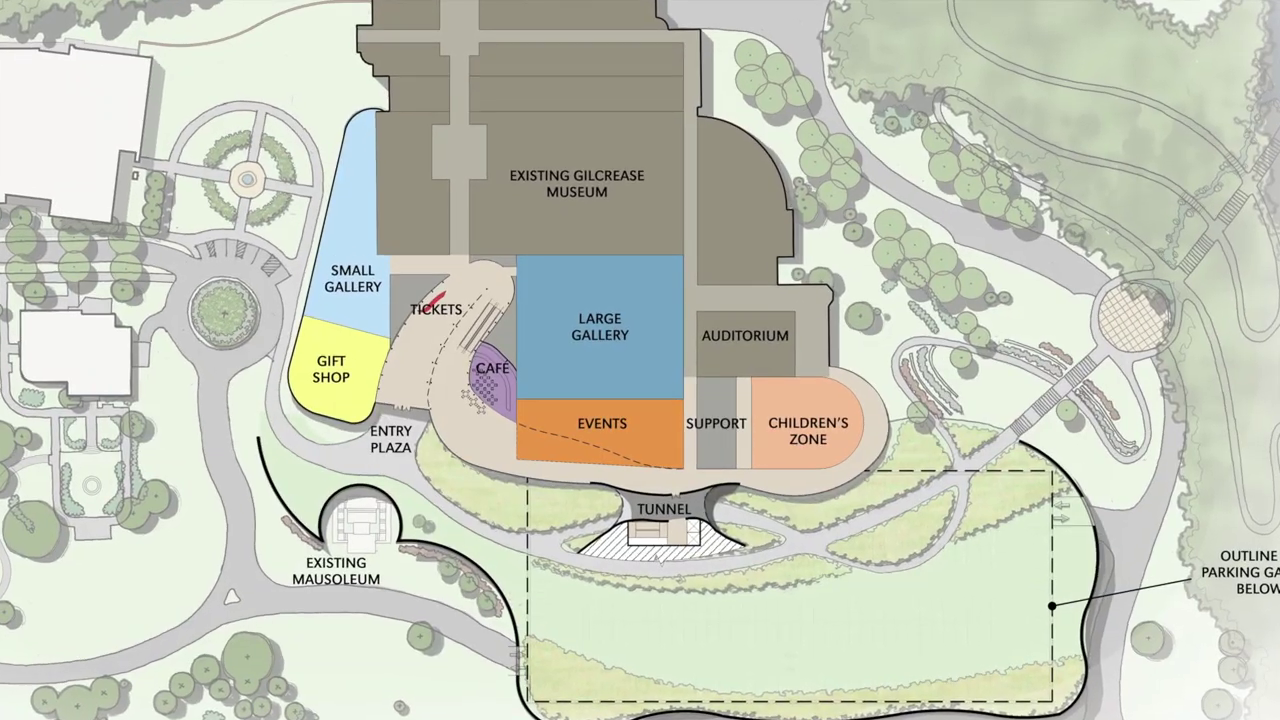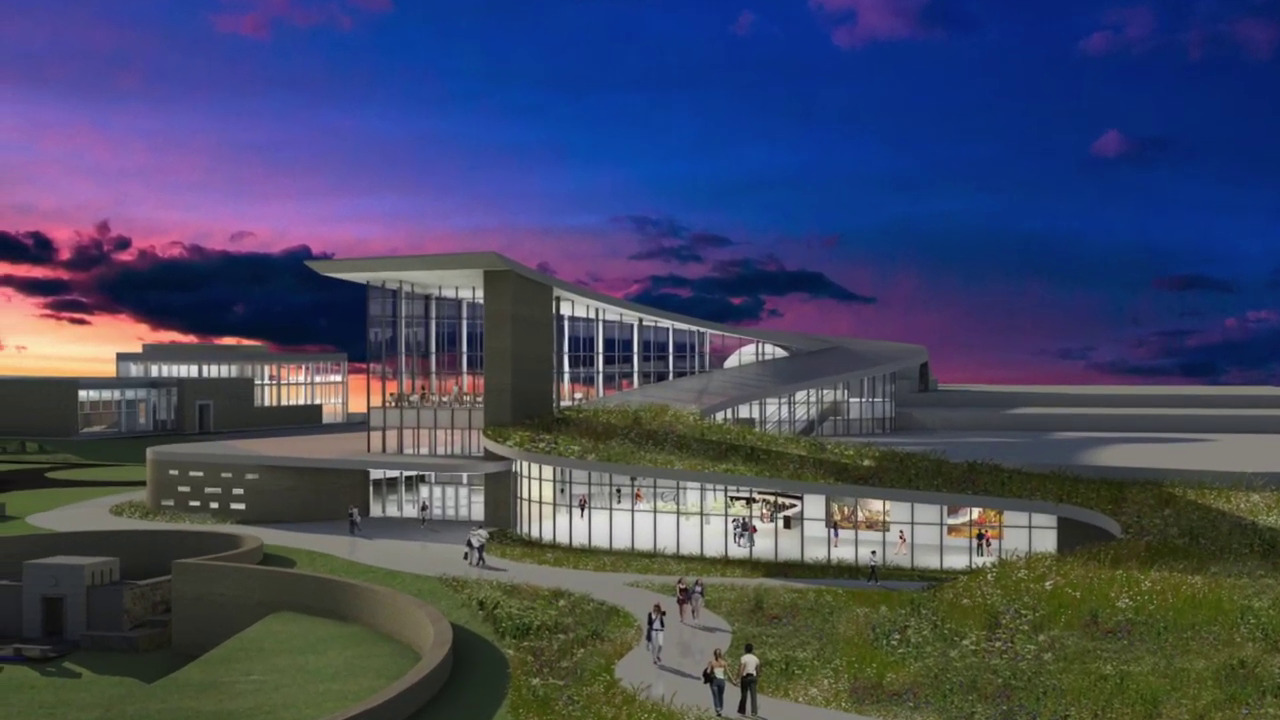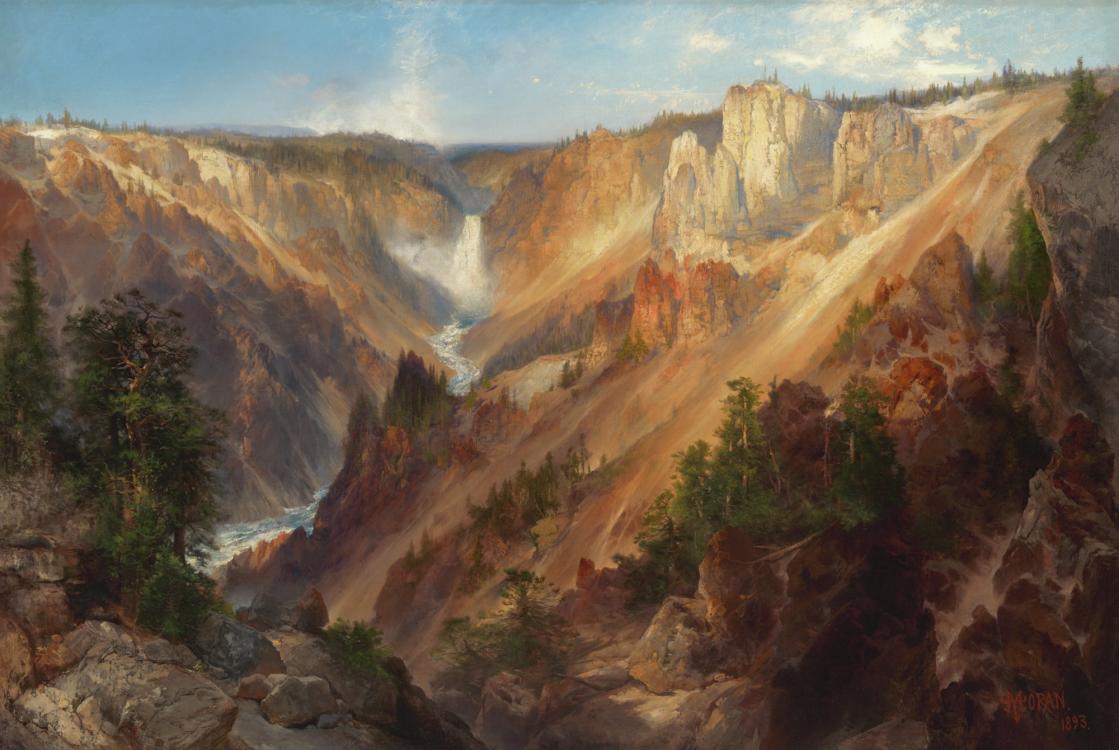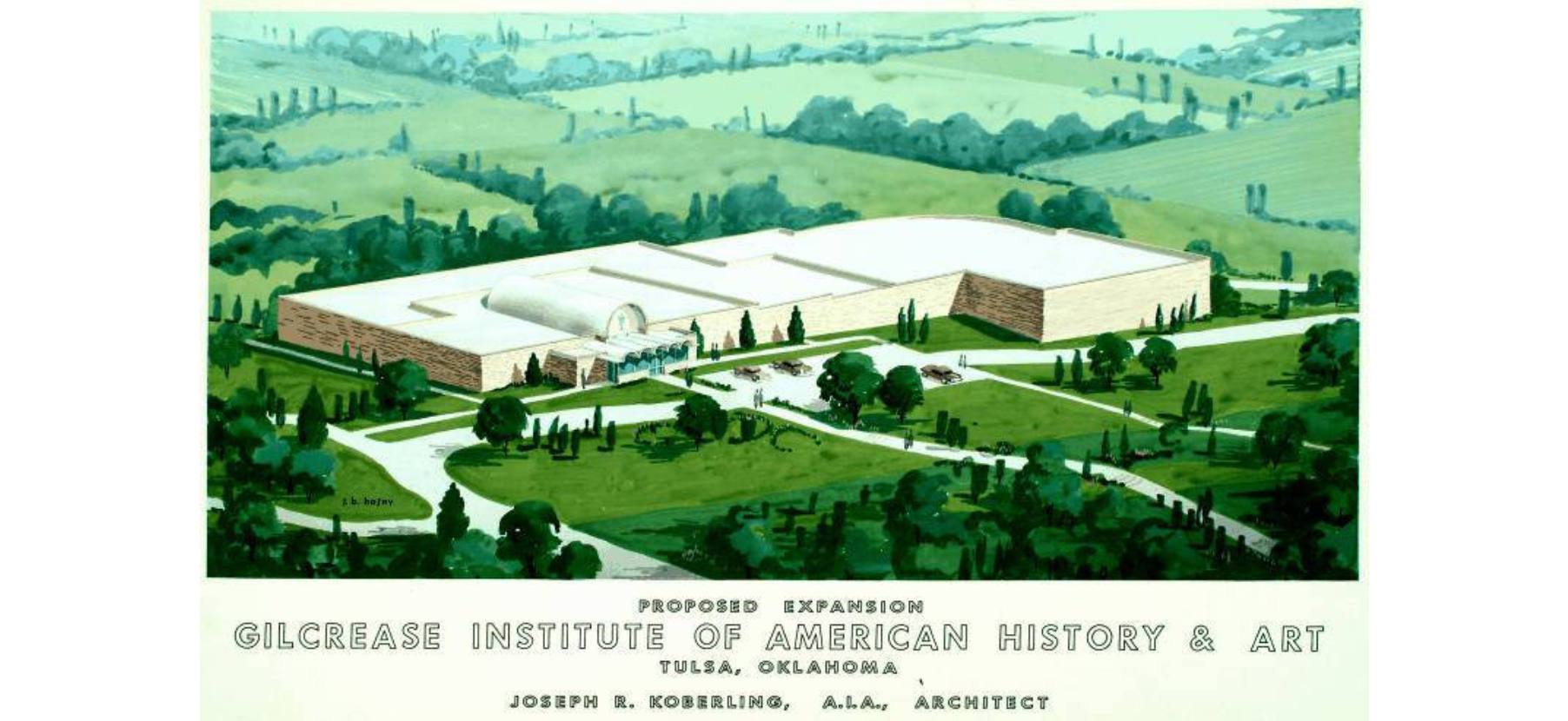Goodbye, Gilcrease
You have five more days (Wednesday, June 30, 2021, to Sunday, July 4, 2021) to visit Tulsa's Gilcrease Museum before the museum, as you've known it for the last 57 years, goes away forever. The museum is open from 11 a.m. to 4 p.m. every day, with extended hours to 8 p.m. on Thursday. You can book online. The museum is being demolished and replaced, the result of a bait-and-switch with Tulsa voters, who had approved funds for museum expansion.
The City had promised renovating 64,000 square feet of the museum and adding 20,000 square feet of new construction. Here's a video, preceding the 2016 Vision Tulsa vote, showing a floor plan for an expanded museum, with a new entrance, gift shop, and an upward expansion to make the museum visible from downtown.

 Floor plan and conceptual drawing of Gilcrease Museum expansion as proposed prior to the 2016 Vision Tulsa sales tax vote
Floor plan and conceptual drawing of Gilcrease Museum expansion as proposed prior to the 2016 Vision Tulsa sales tax voteThe change in plans was substantial enough to require public notice and City Council amendment of the Brown Ordinance governing the sales tax funds. The existing 134,000 sq. ft. building is being replaced with an 83,500 sq. ft. facility.
At 83,500 square feet, the new Gilcrease Museum will be markedly smaller than the existing one, a 134,000-square-foot structure built as a 1913 carriage house and subject to numerous expansions over the decades.
Note that this number is even smaller than reported when the demolition plan was first revealed.
While proponents claim, "By being thoughtful about the design, the 89,000-square-foot facility will have more exhibition space than the current 134,000-square-foot structure," I expect to learn, when the new building opens, that they tried and tried, but could not produce the added exhibition space within the constraints of the budget.
This past weekend, conceptual drawings of the new facility were released: A characterless glass box, surrounded by unshaded outdoor plazas. The Gilcrease Vision Task Force, appointed by Mayor G. T. Bynum IV, chose the firms redesigning the museum; I have so far been unable to locate a list of the members of this task force.
We had a rushed visit on Sunday afternoon, with plans to return one more time this week. Gilcrease Museum holds many happy memories for our family, like the 2006 city inauguration, which we attended with our brand new baby boy, celebrating the swearing-in of John Eagleton, Rick Westcott, and Maria Barnes; or special exhibits like Ansel Adams (2009), George Washington (2012), Thomas Moran, Norman Rockwell, and Dorothea Lange. For many years, Gilcrease hosted Santa Claus (aka my dad) for a special seasonal Funday Sunday; for our family, it was a chance for a family Christmas photo and to reacquaint ourselves with the masterpieces on display.

During our visit this past Sunday, several galleries were off-limits, including the gallery on the southwest corner of the building and the traveling exhibition gallery. The recreated artist's studio is gone. The large gallery that was once dedicated to paintings of the American West is now called "Americans All! / Americanos Todos!" devoted to art by immigrants. This gallery, uniquely in the museum, has captions in both English and Spanish. It includes works by great artists of the American West who once had dedicated galleries at Gilcrease -- Thomas Moran (from England), O. C. Seltzer (from Denmark), and Albert Bierstadt (from Germany) -- but it also includes works of less significance (to be kind) by more recent immigrants. Included in this latter category is a selfie-video of a young Mexican woman, Carmen Castorena, who was allowed to stay in the US under Obama's DACA program.
The Perfect Tommy Girl by Carmen CastorenaThis performance piece examines my alteration process in becoming the ultimate American me. The setting is my bathroom. As I see my reflection and "operate" on myself through multiple bleaching procedures, lightening of my eyebrows, removal of facial hair, and changing the color of my eyes, I eat a bowl of fresh cacti. The phrase, "Nopal En La Frente (Cactus on Your Forehead)," is used to mock those who go around pretending they are not Mexican. The consumption of this native plant is a way to communicate that no matter what physical procedures you may undergo, a Mexican can never fool anybody into thinking they aren't Mexican. There is a battle between the exterior (seeing the physical changes) and interior (processing those changes) that forms the focal point of the performance. This video is my way of channeling years of alienation and reaching closure in the creation of my "ideal self."
(It's useful to know that attempts at trans-ethnic transformation are futile. The notion is applicable to other situations: "No matter what physical procedures you may undergo, a [male] can never fool anybody into thinking [he] [is]n't [male].")
A room of the gallery that might have been used to display more of the beautiful landscapes and Native American art stored in the vaults was instead used for two walls of editorial cartoons -- one by Bruce Plante, one by Thomas Nast -- advocating for unrestricted immigration -- and two walls with infographics designed to push the same political line.
This should be seen as a preview of the reborn Gilcrease Museum: The great works depicting the vast frontier of the American West will be displayed only to the extent needed to support new works that push a political message. The mingling of old and new is an effective strategy: We certainly would not have bothered with the exhibit except for the presence of iconic Gilcrease works by artists like Moran, Bierstadt, Seltzer, John James Audubon, and Augustus Saint Gaudens.
Want more evidence of the downgrade? Here's a video from Gilcrease Museum Senior Curator Laura Fry, speculating that painter Alfred Jacob Miller, his patron William Drummond Stewart, a Scottish nobleman and veteran of the Battle of Waterloo, and Antoine Clement, a French / Cree buffalo hunter, engaged in homosexual acts with one another, based on Miller never marrying and the friendship between the three men. Stewart had invited Miller to accompany him to the great trappers' rendezvous in 1837 in present-day Wyoming. Stewart commissioned Miller to paint scenes of the American West to decorate Murthly Castle in Dunkeld, Scotland. Clement was principal hunter of Stewart's traveling party. According to her LinkedIn profile, Fry was a member of the Mayor's Gilcrease Vision Task Force which authorized the ugly new building. The Gilcrease YouTube channel includes more of this sort of nonsense, like a presentation on "Gender in Pre-Columbian Cultures and Native Communities Today," part of a November 2018 symposium on gender.
Museums are part of the overall kulturkampf of the Left, the Long March through the Institutions. I will be saddened but unsurprised if long-time favorites, landscapes and scenes of the American West from the core of Thomas Gilcrease's collection, are never returned from storage, for lack of space, you understand.
According to some accounts, Thomas Gilcrease founded his museum in San Antonio in 1942 and moved it to Tulsa in 1949. But an Associated Press story in the December 20, 1942, Daily Oklahoman says that the "San Antonio oil man's 80-acre [Tulsa] estate has not been occupied for several years" and was being transformed "into a museum and orphanage for Indian children... by a crew of carpenters and painters.... The institution will be supported by the Thomas Gilcrease Foundation. The oil man has donated valuable assets and his extensive collection of Indian relics to the foundation."
Part of the building is said to date back to 1913. Walls of rough-hewn sandstone block can still be seen on the north and south sides of the building where they haven't been enclosed or superseded by later additions.
The Thomas Gilcrease Institute of American History and Art was transferred to the City of Tulsa on January 27, 1955, after citizens approved a bond issue in August 1954 for $2.25 million to pay the debts of oilman Thomas Gilcrease, staving off the dispersal of his priceless collection of the art and artifacts of the American West. (This video by Fry describes the early history of the museum.) The bonds were repaid over time by revenues from Thomas Gilcrease's oil assets. While the original mid-50s concept for the Civic Center included a 42,600 sq. ft. facility for the Gilcrease collection, in 1958, the existing grounds and building, which had been leased from Thomas Gilcrease, were deeded to the city. In 1961, Tulsans voted a half-million dollar bond issue for a museum expansion that opened to the public on October 27, 1963, which added the Vista Room and a 250-seat auditorium, tripling the size of the museum and enabling 40% of the collection at that time to be put on display. At the grand opening, the Gilcrease Foundation announced it was donating to the City 10.5 acres of land and its collection of art and artifacts, valued at $5 million in 1963.
A museum map from that period shows the following galleries:
- Introductory to the Collections
- American Classics
- Remington Collection
- Russell Collection
- Taos Artist
- Seltzer - Leigh - Johnson
- Landscapes - Treaties - People
- Special Exhibit - Willard Stone Sculpture
- Thomas Moran
- George Catlin - Alfred Jacob Miller
- Artifacts
Gilcrease Museum expanded again in the 1980s, this time with $12.25 million in private funds, to add a gift shop, restaurant, and additional exhibit space, including Helmerich Hall with its double-barrel-vaulted ceiling as the new heart of the museum and space for a conservation laboratory and anthropological collections. The museum doubled in size to 127,786 sq. ft. The new space opened on November 7, 1987. During the 1980s, admission was free, and the museum was open weekdays 9 to 5 and 1 to 5 on Sundays. The City of Tulsa has since provided additional capital funding for improvements via "Third Penny" sales taxes and bond issues. In September 2014, the Helmerich Center for American Research opened its doors.
So go see Gilcrease before it is transformed into something expensively worse. And next election, replace Bynum IV and the City Council with officials who will insist that the City of Tulsa's Gilcrease collection of art be curated and displayed to celebrate the American West, in the spirit of the oil man who brought it together and gave it to us.
0 TrackBacks
Listed below are links to blogs that reference this entry: Goodbye, Gilcrease.
TrackBack URL for this entry: https://www.batesline.com/cgi-bin/mt/mt-tb.cgi/8839
